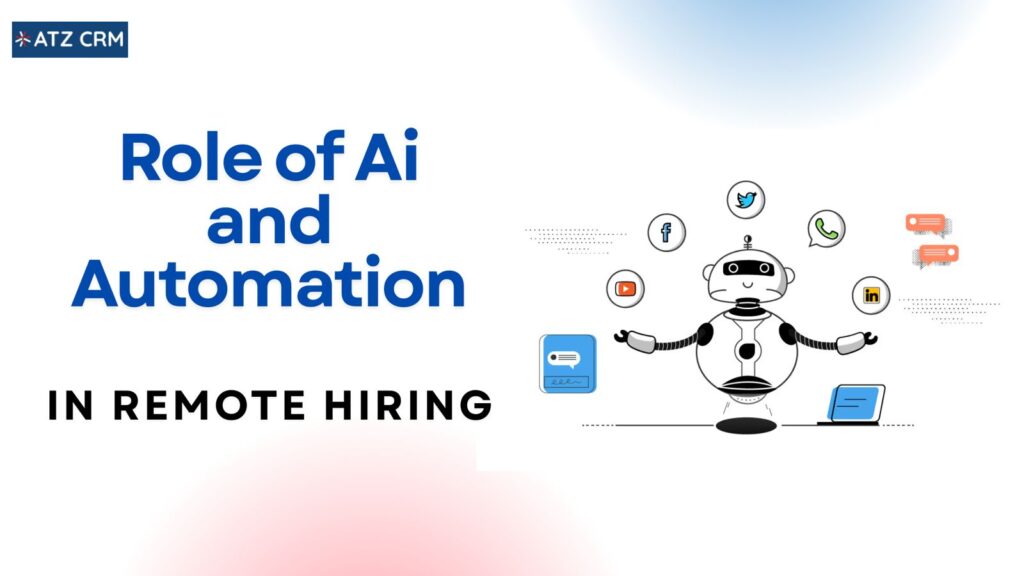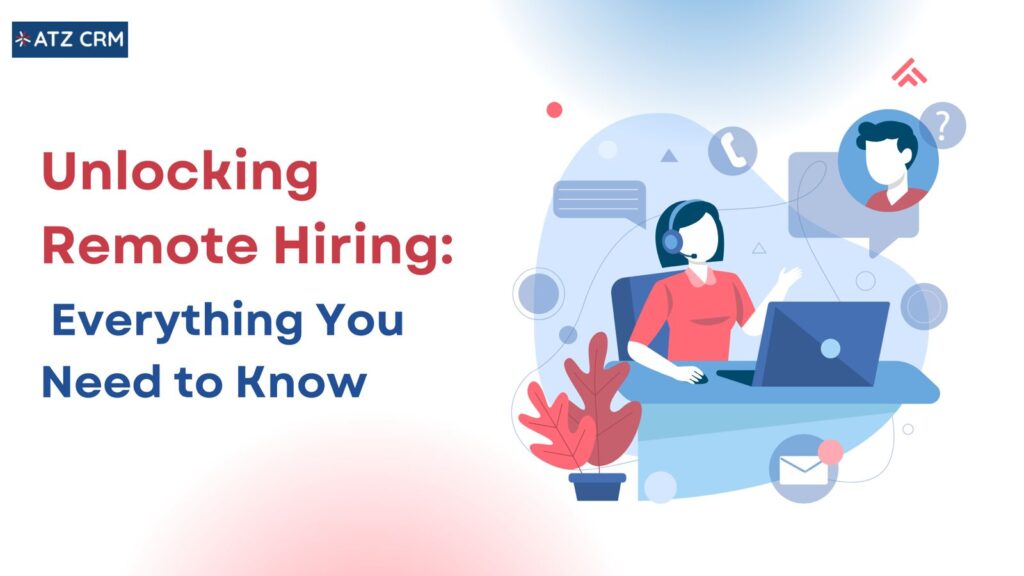In today’s evolving workforce, remote hiring has become a crucial approach for organizations aiming to build diverse, flexible, and globally connected teams. By removing geographical boundaries, companies can now attract top talent from around the world, all while embracing a more adaptable work culture. Here, we explore remote hiring essentials—from overcoming challenges to understanding future trends—so your team can excel in this digital era. Throughout, we’ll also share resources from ATZ CRM to enhance your hiring strategies.
Related read: Explore our 10 Proven Ways to Streamline Hiring for more insights on refining the recruitment process.
Understanding Remote Hiring: The New Norm
Remote hiring is no longer a temporary solution; it’s shaping the future of work. With its many benefits, including reduced costs, flexibility, and a broader talent pool, remote hiring is a strategy that more companies are adopting to remain competitive.
Building a Remote Dream Team: A Step-by-Step Guide
Hiring a successful remote team requires more than just finding skilled candidates—it’s about creating an efficient and engaging process from start to finish. A clear structure ensures both the company and candidates feel aligned.
Step-by-Step Guide to Remote Hiring
- Define the Role
Craft detailed job descriptions that highlight responsibilities, skills, and expectations for remote work. Transparency attracts the right candidates.
- Use Technology for Sourcing
Leverage AI recruitment tools and job boards tailored to remote roles. These tools can streamline sourcing and match you with ideal candidates.
- Conduct Virtual Interviews
Use video interviews on platforms like Zoom or Google Meet to assess skills and fit. Provide clear guidelines to make the process smooth and professional.
- Evaluate Communication Skills
Strong communication is essential for remote work. Assess candidates’ ability to express ideas clearly and their comfort with digital tools like Slack or Teams.
- Highlight Company Culture
Share insights into your remote work environment through team introductions or a preview of tools and workflows. This builds excitement and clarity.
- Onboard Virtually
Use onboarding software to prepare new hires with training materials, policies, and schedules. Tools like BambooHR make the process seamless.
Essential Tools for Remote Hiring
- Collaboration: Slack, Asana, or Teams for streamlined communication.
- Interviews: Zoom or Skype for virtual meetings.
- Onboarding: BambooHR or Trainual for efficient employee integration.
Investing in the right tools and creating a smooth hiring process ensures a connected, productive remote team.
For advanced strategies, explore ATZ CRM’s guides on AI recruitment and candidate engagement to elevate your hiring game.
Overcoming Challenges in Remote Hiring
As promising as remote hiring is, it comes with unique challenges. However, with the right strategies, companies can overcome these hurdles effectively.
Managing Time Zone Differences
One common issue is coordinating across different time zones. Offering flexible interview times or recording sessions for asynchronous review can make scheduling easier.
Evaluating Skills and Building Trust
When hiring remotely, assessing candidates’ skills and building trust can feel more complex. Leveraging virtual assessment tools and conducting structured behavioral interviews can help ensure you’re hiring candidates who can thrive in a remote setting.
Trends in Remote Hiring: What’s Ahead in 2024
As technology advances, so do remote hiring practices. Staying informed about these trends can help companies streamline processes and improve candidate experiences.
AI-Powered Screening and Automation
AI is transforming hiring processes, with tools that can quickly screen resumes and assess candidate fit. By automating the initial stages, recruiters can spend more time engaging with top candidates.
Virtual Assessments and Tools
From coding challenges to personality assessments, virtual tools allow employers to see a more comprehensive view of a candidate’s skills. For the latest on AI in recruitment, check out ATZ CRM’s guide on AI-driven recruitment, which dives into the benefits and potential of AI for hiring.
Engaging Remote Candidates Throughout the Hiring Process
Keeping candidates engaged is critical, especially when they may never step foot in a physical office. Strong engagement strategies can make all the difference in keeping potential hires interested and excited.
Consistent Communication and Check-Ins
Regular updates and timely responses can help remote candidates feel connected to the process. Candidates who feel valued are more likely to be enthusiastic about joining.
Showcasing Culture Virtually
Providing virtual glimpses into your company’s culture is key to candidate engagement. Share videos, host Q&A sessions with current employees, and allow candidates to experience what it’s like to work with your team.

The Role of AI and Automation in Remote Hiring
AI and automation are becoming game-changers in remote hiring, helping companies speed up processes and focus on what really matters. These technologies handle repetitive tasks like sifting through resumes, scheduling interviews, and sending follow-up emails, which frees up recruiters to spend more time engaging with candidates. However, while these tools are incredibly useful, it’s important to remember that hiring is still a human process—AI and automation should complement the personal touch that makes a candidate feel valued.
Striking the Right Balance
The real challenge is using AI and automation in ways that improve efficiency without losing the human side of recruitment. AI can take over the tedious work, like screening resumes or sending out mass emails, which speeds up the process. But it’s the recruiter’s job to make sure candidates have a good experience, answer their questions, and make them feel like they’re more than just a name on a list. It’s all about finding a balance: using automation to save time and scale up while still keeping the personal connection that makes a candidate feel heard and appreciated.
The Benefits and Limitations of AI
AI has a lot to offer in remote hiring. It can quickly analyze resumes, identify top candidates, and even help automate communication. This can save a lot of time and ensure no candidate slips through the cracks. However, AI isn’t perfect—it’s only as good as the data it’s trained on, and there’s always the risk of algorithmic bias. This is why human involvement in the decision-making process is still crucial. Having recruiters review AI’s recommendations helps ensure the process is fair, inclusive, and aligned with your company’s values.
For further details on the role of AI in recruitment, check out this article on Oorwin.
Remote Hiring vs. In-Person Hiring: Which Is Better?
When it comes to remote vs. in-person hiring, there’s no one-size-fits-all answer. Both approaches have their strengths, and the right choice depends on your company’s needs, the role in question, and your organizational culture. Let’s break it down a bit more:
Evaluating the Fit for Your Organization
- Team Dynamics: If your company thrives on close collaboration and spontaneous in-person brainstorming sessions, in-person hiring might make more sense. You’ll have the benefit of real-time communication and face-to-face interactions. Remote work, however, requires more structured communication and intentional effort to stay connected. But with the right tools, remote teams can be just as collaborative and efficient.
- Nature of the Work: Some roles, like those in healthcare, manufacturing, or customer service, might require in-person presence, where physical tasks or direct customer interactions are a must. Remote roles, like those in tech, marketing, or design, can often be done just as effectively from anywhere, allowing companies to tap into talent from all over the world.
- Budget: Remote hiring can help companies save on overhead costs like office space, utilities, and commuting subsidies. It’s especially useful for smaller businesses or startups that want to scale without the financial burden of maintaining a physical office. On the flip side, in-person hiring might be better if your company values face-to-face collaboration and building a strong office culture.
- Flexibility: If offering flexibility is important to your company, remote hiring is a fantastic option. It allows employees to work from anywhere, at any time, which can lead to better work-life balance and increased job satisfaction. Many remote jobs also offer flexible hours, which can help employees manage personal commitments and avoid burnout.
At the end of the day, whether you go remote or in-person depends on your company’s goals and values. Some businesses thrive with remote teams, while others find in-person interactions lead to more effective collaboration. A hybrid model, combining both remote and in-person elements, is another great option to consider. By thinking about what fits best for your organization’s culture and objectives, you can make the best decision for your hiring strategy.
Tips for Managing Cross-Cultural Recruitment
Hiring globally means embracing different cultural perspectives, which can be enriching but also requires careful communication.
Encouraging Inclusive Communication
When working with a multicultural team, it’s crucial to have a communication strategy that respects cultural nuances. Training on cultural sensitivity can foster stronger bonds within a remote team.
Building an Inclusive Hiring Process
An inclusive hiring process promotes a welcoming atmosphere and reflects positively on your brand. Make inclusivity a priority by being transparent about company values and by actively seeking diverse perspectives.
Looking to the Future: Innovations in Remote Hiring
As technology advances, new possibilities are emerging in remote hiring. Staying updated on these innovations can give companies a competitive edge.
Virtual Reality and Automated Interviews
Imagine using virtual reality to simulate work environments for candidates or conducting interviews through fully automated platforms. These technologies are on the horizon, offering exciting new ways to engage with candidates remotely.
Upcoming Trends to Watch
Blockchain for credential verification, AI-driven skills matching, and immersive candidate experiences are just a few of the developments that could shape the future of remote hiring. Keeping up with these trends ensures companies can attract top talent in innovative ways.
Conclusion
Build tomorrow’s team today by tapping into the potential of remote hiring. Imagine connecting with skilled professionals from around the world, breaking down borders, and building a team that’s ready to thrive anywhere. Remote hiring gives you the freedom to find the perfect fit, no matter where talent is.
With ATZ CRM’s resources and tools, you’re equipped to make remote hiring seamless, keeping your team engaged and connected, even miles apart. Embrace the future of work—wherever your next great hire may be, your opportunities are limitless.


